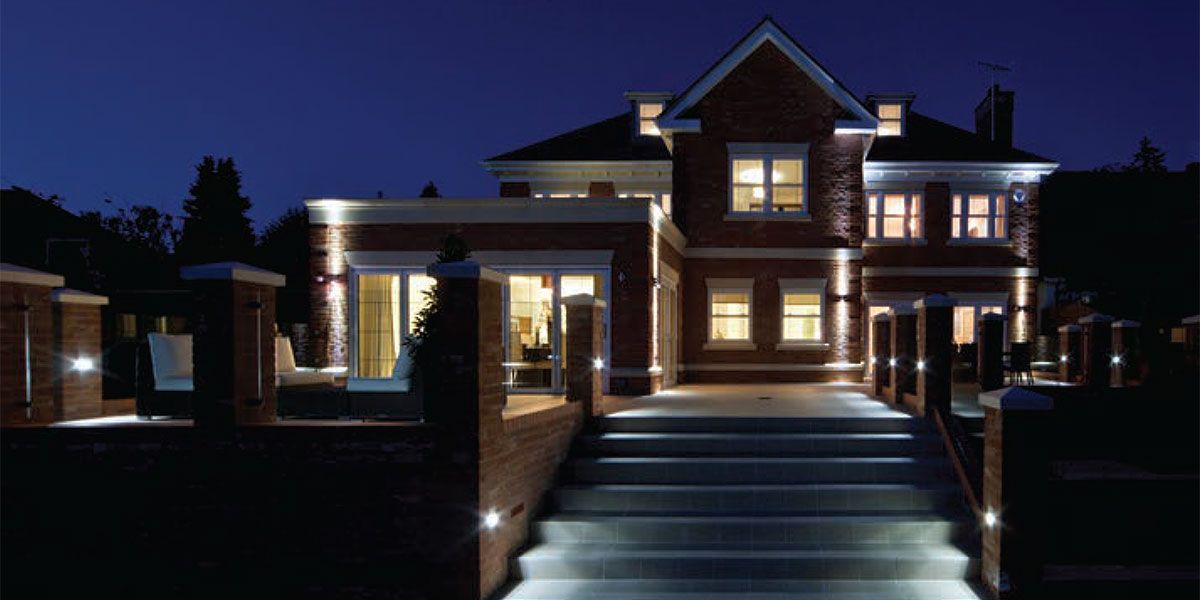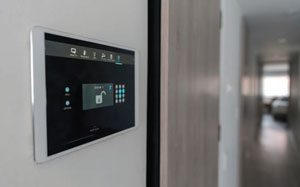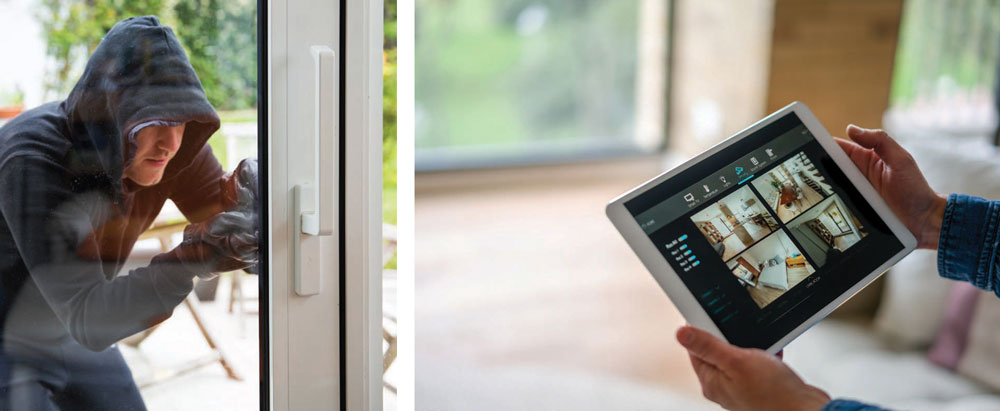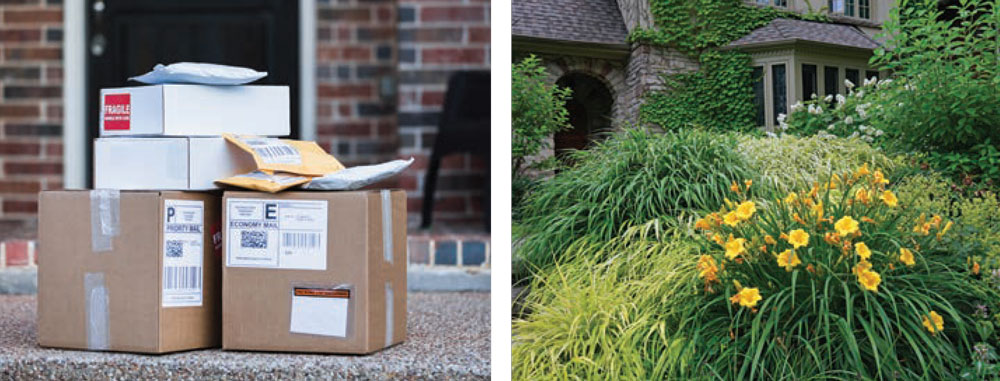SECURING YOUR HOME

Team up old-school safety smarts with digital tools
Every homeowner deserves to feel safe and secure inside their residence. Unfortunately, in a world where criminals don’t hesitate to prey on those who aren’t well protected from break-ins, some forethought, behavior change and modifications to your property are likely needed to help protect you from potential invaders. While digital tools abound, don’t forget to take common-sense measures to stay safe.
Start with the basics
Begin your safety assessment with these routine precautions:
- Always lock all doors and windows when leaving home or retiring for the night.
- Install high quality door locks.
- Supplement the locks on sliding doors with a commercial slide blocking device, available online or from home stores, or a length of heavy dowel (an old broom handle will do) fitted into any sliding door’s lower slide channel.
- Set timers on a couple of lamps when you are going to be away after dark. Timers with “random-on-time” settings are preferred if you are going to be away from home several days in a row. For long-term use, choose timers that are ambient light sensitive so the “on” time will vary as daylight patterns change.
- Don’t let mail or packages pile up while you’re away. Stop your mail or have a neighbor gather up packages if you’re on vacation.
- Carefully conceal any hidden keys (definitely not under the doormat, above the door or in some other obvious location).
- Illuminate areas where a burglar might crouch near your doors and windows. Motion-detecting fixtures or bulbs inexpensively provide responsive lighting outside your home.
- Periodically trim back shrubbery that might otherwise provide convenient screening for a break-in artist.
- Keep valuables out of sight in a hidden spot, home fire safe or bank safety deposit box.
Fight daytime break-ins
“FBI statistics show that the vast majority of break-ins occur during the day, when people are away from home,” notes Lt. Scott Arnes of the Bedford County Sheriff’s Department. “So locking up when leaving home is a no-brainer.”
 In addition to locking up, you can also protect your home in the daytime with digital home-security devices. Prices for outdoor and indoor security monitoring cameras are steadily decreasing; most offer “apps” that will alert your smartphone whenever suspicious activity is detected and capture images of potential intruders. Additionally, signs indicating that your property is being monitored can be effective deterrents: FBI statistics show that 83% of would-be burglars avoid homes with security systems when selecting their targets.
In addition to locking up, you can also protect your home in the daytime with digital home-security devices. Prices for outdoor and indoor security monitoring cameras are steadily decreasing; most offer “apps” that will alert your smartphone whenever suspicious activity is detected and capture images of potential intruders. Additionally, signs indicating that your property is being monitored can be effective deterrents: FBI statistics show that 83% of would-be burglars avoid homes with security systems when selecting their targets.
Modern home security systems fall into three main categories:
- Wired local alarm system. This most-basic setup includes sensors on doors and windows that will set off an audible alarm when tripped. These alarms are not connected to a central monitoring station or any company operators and cannot be controlled remotely. Such systems rely on a piercing sound to warn intruders they’ve been detected and suggest that law enforcement may be on the way.
- Wired digital alarm system. These systems incorporate multiple sensors connected to a central control panel that can shut off the system or alert authorities of an intrusion. Upon detection of a break-in or fire, they typically communicate with a monitoring call center that notifies appropriate responders and/or takes other action the homeowner may have specified.
- Wireless alarm systems. A wireless system will notify a cell phone app or a digital communicator via cell towers or Internet Protocol — as opposed to vulnerable phone lines — to alert the homeowner or a monitoring service to a potential security breach. Homeowners can also use their phones to enable/disable the system and to monitor, for example, the activities of a teenager left home alone or a pet-sitter who has been given access to the home in their absence. Doorbell cameras fall into this category and are both low cost and easily DIY installed. When activated by motion, they transmit a video image to the homeowner’s phone or tablet using an included smartphone app.
Enlist dogged determination
While some professional thieves may have experience circumventing in-home alarm systems, break-in artists are known to routinely avoid properties where they have reason to believe large dogs reside. A serious-sounding dog bark, real or recorded, will usually send a burglar to a softer target. Evidence of a sizable dog in residence — like a large dog bowl, bone, chewy toy or even grungy-looking tennis balls left conspicuously visible — may help redirect would-be burglars to a less-threatening “opportunity.”
Homeowners who are willing to invest a bit more in home security have options that include professional installation of a full array of indoor and outdoor motion-sensitive cameras, with digital recording storage capability. A quality system can cost well into the thousands but will provide a video record should a security/safety incident occur as well as serve as an effective deterrent. (Burglars take notice of such installations and of window decals that warn a home is wired!)
A security professional will also make sure your exterior doors are sufficiently sturdy and your door and window locks are of high enough quality to defeat all but the most skilled of unauthorized enterers. Security specialists (ADT is one that gets good reviews) can perform an entire analysis of your home and recommend actions to improve your security posture.
As with other aspects of personal well-being, good home security requires your attentiveness. A conscious checkup now, before an incident occurs, is the surest way to minimize the likelihood of an inconvenient or potentially dangerous break-in. ✦
break-ins, digital home-security, digital tools, dog bark, home security systems, monitoring cameras, security, security specialists, slide blocking, timers, wired digital alarm system, wired local alarm system, wireless alarm systems









